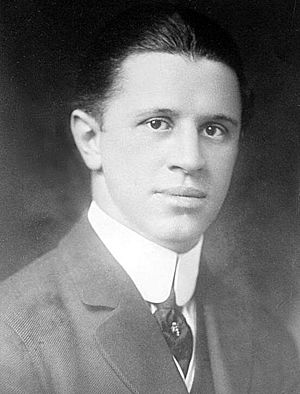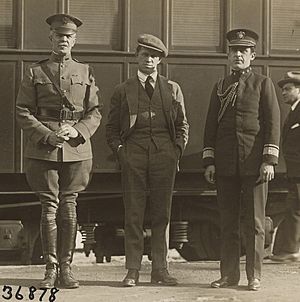George Creel facts for kids
Quick facts for kids
George Edward Creel
|
|
|---|---|
 |
|
| Born | December 1, 1876 |
| Died | October 2, 1953 (aged 76) |
| Occupation | Journalist |
| Title | Head of the United States Committee on Public Information |
George Edward Creel (born December 1, 1876 – died October 2, 1953) was an American journalist, writer, and government official. He was known for his work as an investigative journalist, meaning he dug deep to find facts and expose problems. During World War I, he led the United States Committee on Public Information. This group was created by President Woodrow Wilson to share information and build support for the war.
Contents
Early Life and Learning
George Creel was born in Lafayette County, Missouri, on December 1, 1876. His mother, Virginia Fackler Creel, had a big influence on him. She supported her family by running a boarding house and sewing. George often said his mother was very smart and capable. She encouraged his love for books and history, even teaching him about classics like the Iliad.
George didn't go to school much because his mother taught him at home. When he was 15, he ran away for a year. He worked at county fairs and took odd jobs to support himself. Even though he was a bit rebellious, he did attend Kansas City Central High School and Odessa College for a short time. His mother's strong beliefs also inspired him to support women's suffrage, which was the right for women to vote.
George Creel's Career Journey
Starting Out as a Journalist
In 1896, George Creel got his first real job at the Kansas City World newspaper. He started as a reporter and later wrote special articles. He also wrote about books and social events. He was fired because he disagreed with his editors about publishing a story he felt was private.
After that, he moved to New York and worked as a freelance joke writer for famous newspaper owners like William Randolph Hearst and Joseph Pulitzer. He worked very hard, writing many jokes, and soon his work was published regularly.
Becoming a Newspaper Owner
In 1899, Creel returned to Kansas City and started his own newspaper, The Independent. He became the owner, editor, and publisher at just 23 years old. In his paper, he wrote about important social issues. These included women's suffrage (the right for women to vote) and the idea of public ownership of utilities, meaning things like water or electricity companies should be owned by the community, not private businesses.
Creel was a strong supporter of the Democratic Party. However, he always put the public good first, even if it meant supporting someone from a different political party. For example, he supported Republican Herbert S. Hadley for Governor of Missouri, because Hadley was a reformer who wanted to make things better. Creel believed that being a good citizen meant caring more about the community than about political parties.
Working in Colorado and for President Wilson
In 1909, Creel moved to Colorado. He became an editorial writer for the Denver Post. He gained attention for his strong opinions on public issues. Later, in 1912, he was appointed Police Commissioner of Denver. He tried to make many reforms, but he was eventually dismissed for disagreeing with the mayor.
In 1916, Creel played a big part in President Wilson's campaign to be re-elected. He wrote articles and interviewed people. When World War I began, some military leaders wanted to control what the press could say about the war. Creel told President Wilson that he believed in "expression, not suppression" for the press. Wilson agreed and chose Creel to lead the Committee on Public Information.
Leading the Committee on Public Information

Just seven days after the United States joined World War I in April 1917, President Woodrow Wilson created the Committee on Public Information (CPI). This group was a propaganda agency, which means it was designed to share government news and build support for the war. George Creel was put in charge. He set up 37 different sections within the CPI.
One important section was the Division of Pictorial Publicity. Talented artists created over 1,000 designs for posters and cartoons. These images helped make people feel patriotic and interested in the war effort. Creel said these images "caught even the most indifferent eye."
Another key part was the Four Minute Men division. About 75,000 volunteers spoke to millions of people in short, four-minute speeches. They spoke at places like movie theaters, which was the time it took to change a movie reel. They talked about important war topics like the draft (joining the military), rationing (saving food and supplies), bond drives (buying bonds to help fund the war), and victory gardens (growing food at home). Creel wanted these speeches to be full of facts and appeal to people's emotions to get their support.
The News Division and Censorship Committee helped Creel control the flow of official war information. Creel wanted to share facts without bias, but much of the news was "colored by nationalistic assumptions," meaning it favored the US. Creel hoped the US could avoid strict censorship. He only wanted to stop information that was "dangerous" or "unfavorable" to prevent people from losing hope.
The CPI stopped its work on November 11, 1919, when the war ended. The CPI's efforts were seen as the biggest public relations campaign in history at that time. It showed how powerful mass persuasion and social influence could be on a national level. Many important public relations experts of the 20th century learned their skills while working with Creel on this committee.
After the War
After his important role leading the CPI, George Creel became a writer for Collier's magazine. He continued this work until he retired in the late 1940s. In 1926, he moved to San Francisco.
He remained active in the Democratic Party. In 1934, he ran for governor of California but lost in the primary election to Upton Sinclair.
Books and Articles by George Creel
George Creel wrote many articles and books during his life. Some of his books include:
- Quatrains of Christ. 1907.
- Children in Bondage. (Co-written). 1913.
- Wilson and the Issues. 1916.
- Ireland's Fight for Freedom. 1919.
- How We Advertised America. 1920.
- The War, the World and Wilson. 1920.
- Uncle Henry. 1923.
- Sam Houston. 1928.
- Tom Paine Liberty Bell. 1932.
- Rebel at Large. 1947.
- Russia's Race for Asia. 1949.
Personal Life
George Creel married actress Blanche Bates in 1912. They had two children, a son named George Jr. and a daughter named Frances. Blanche passed away in 1941. In 1943, he married Alice May Rosseter. George Creel lived in San Francisco during his later years and passed away on October 2, 1953.
See also
 In Spanish: George Creel para niños
In Spanish: George Creel para niños

